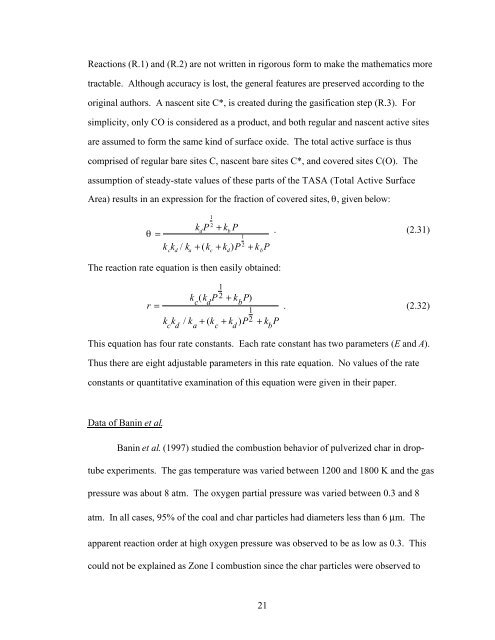MODELING CHAR OXIDATION AS A FUNCTION OF PRESSURE ...
MODELING CHAR OXIDATION AS A FUNCTION OF PRESSURE ...
MODELING CHAR OXIDATION AS A FUNCTION OF PRESSURE ...
Create successful ePaper yourself
Turn your PDF publications into a flip-book with our unique Google optimized e-Paper software.
Reactions (R.1) and (R.2) are not written in rigorous form to make the mathematics more<br />
tractable. Although accuracy is lost, the general features are preserved according to the<br />
original authors. A nascent site C*, is created during the gasification step (R.3). For<br />
simplicity, only CO is considered as a product, and both regular and nascent active sites<br />
are assumed to form the same kind of surface oxide. The total active surface is thus<br />
comprised of regular bare sites C, nascent bare sites C*, and covered sites C(O). The<br />
assumption of steady-state values of these parts of the T<strong>AS</strong>A (Total Active Surface<br />
Area) results in an expression for the fraction of covered sites, , given below:<br />
=<br />
1<br />
2 kdP + kb P<br />
1<br />
2 k ckd / ka + (kc + kd )P + k bP . (2.31)<br />
The reaction rate equation is then easily obtained:<br />
r =<br />
1<br />
k<br />
c<br />
(k<br />
d<br />
P 2 + kbP) 1<br />
k<br />
c<br />
k<br />
d<br />
/ k<br />
a<br />
+ (k<br />
c<br />
+ k<br />
d<br />
)P2<br />
+ kbP 21<br />
. (2.32)<br />
This equation has four rate constants. Each rate constant has two parameters (E and A).<br />
Thus there are eight adjustable parameters in this rate equation. No values of the rate<br />
constants or quantitative examination of this equation were given in their paper.<br />
Data of Banin et al.<br />
Banin et al. (1997) studied the combustion behavior of pulverized char in drop-<br />
tube experiments. The gas temperature was varied between 1200 and 1800 K and the gas<br />
pressure was about 8 atm. The oxygen partial pressure was varied between 0.3 and 8<br />
atm. In all cases, 95% of the coal and char particles had diameters less than 6 μm. The<br />
apparent reaction order at high oxygen pressure was observed to be as low as 0.3. This<br />
could not be explained as Zone I combustion since the char particles were observed to
















